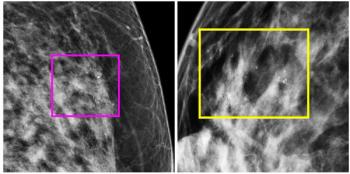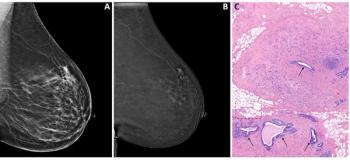
Tomosynthesis Plus Mammography May be Superior to Mammography Alone in Screening
Combination screening finds more cancers, but more research needed to understand impact.
Digital breast tomosynthesis (DBT) plus digital mammography (DM) detects 90 percent more breast cancers than digital mammography alone, according to a study published online in the journal Radiology.
Researchers from Italy performed a two-arm test-and-treat randomized controlled trial to compare the combination imaging approach with mammography alone. A total of 9,777 women (mean age 56.2) participated in the DM+DBT arm and 9,783 women (mean age 56.3 years) in the DM alone arm.
The results showed a recall rate of 3.5 percent in both arms. Eighty-three women in the DM+DBT group had detected cancers (8.6 per 1,000) compared with 44 women (4.5 per 1,000) in the DM alone group. Positive predictive value (PPV) was higher for the combination group at 24.2 percent compared with 13 percent with the DM alone group. DBT alone detected 72 of 80 cancers found in the DBT and digital mammography group. The greater detection rate for combined digital mammography and DBT was notable for small and medium invasive cancers, but not for large ones.
“Tomosynthesis and digital mammography is much more sensitive than digital mammography,” said the study’s principal investigator, Pierpaolo Pattacini, MD, in a release. Pattacini is a radiologist and director of the Radiology Department at AUSL Reggio Emilia in Reggio Emilia, Italy. “The vast majority of the advantage is due to tomosynthesis alone.”
However co-author Paolo Giorgi Rossi, Ph.D., director of the Epidemiology Unit at the same facility pointed out that while DBT’s higher sensitivity would seem to make it a logical choice for breast cancer screening programs, more research is needed to weigh the benefits of improvements in prognosis and reductions in breast cancer-related mortality from DBT against any undesired effects. “If these small cancers would never become life-threatening, then we are increasing overdiagnosis and not impacting mortality,” he said in the release. “Thus, we need to have a measure of the impact of this higher detection rate on the incidence of advanced cancers and interval cancers in the following years.”
Newsletter
Stay at the forefront of radiology with the Diagnostic Imaging newsletter, delivering the latest news, clinical insights, and imaging advancements for today’s radiologists.


























